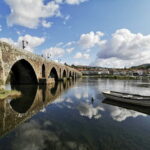
Architectural Treasures of Porto
A Journey Through Time and Style.
Porto, located in the north of Portugal, is a living canvas of architectural evolution. Its streets are layered with centuries of history—from Roman ruins and Gothic spires to Baroque opulence and cutting-edge contemporary design. Walking through the city is like stepping into an open-air museum where art and architecture converge in every corner.
In this guide, we invite you to explore some of the most remarkable architectural landmarks that define the character and spirit of Porto.
Casa da Música
A striking modernist icon, the Casa da Música was designed by renowned Dutch architect Rem Koolhaas for Porto’s designation as the European Capital of Culture in 2001. Although it opened its doors in 2005, its bold geometry and innovative design have since become a symbol of the city’s cultural vibrancy. Beyond its unique architecture, the venue hosts an eclectic program of musical performances—from jazz and classical to rock and electronic. A guided tour reveals its fascinating construction details, but attending a concert truly brings the space to life.
Serralves Museum of Contemporary Art
Set within a vast cultural estate that includes landscaped gardens and an Art Deco villa, the Serralves Museum is one of Europe’s most important contemporary art institutions. The museum, designed by Álvaro Siza Vieira—a recipient of the prestigious Pritzker Architecture Prize—opened in 1999. Serralves is more than just a museum; it is a destination where art, architecture, and nature harmonize. A specialized library, temporary international exhibitions, and immersive installations make it a must-visit for any art lover.
São João National Theatre
A cornerstone of Porto’s theatrical tradition, the São João Theatre dates back to 1794 and was originally designed by Italian architect Vincenzo Mazzoneschi. After a devastating fire in 1908, it was rebuilt in 1920 by José Marques da Silva, a pivotal figure in the transition from classical to modern architecture in Porto. The theatre was later restored in 1992, incorporating designs by architect João Carreira. Don’t miss the richly adorned main hall, featuring an exquisite ceiling painting and four exterior sculptures representing Kindness, Pain, Hate, and Love.
Coliseu do Porto
The Coliseu is one of Porto’s prime examples of Art Deco architecture, inaugurated in 1941. Several prominent architects, including Cassiano Branco, Yan Wils, and Charles Siclis, contributed to its creation. Despite its age, the building still feels remarkably modern and continues to serve as a major cultural venue, hosting everything from rock concerts and operas to ballet and circus performances. The Coliseu reflects Porto’s cosmopolitan character and vibrant artistic scene.
Portuguese Center of Photography
Once a 19th-century prison, the building now houses the Portuguese Centre of Photography, offering a unique fusion of historical architecture and contemporary culture. The transformation of the structure into a modern exhibition space was led by Eduardo Souto de Moura, another Pritzker Prize-winning architect, and Humberto Vieira in 2000. While exploring its exhibits, don’t miss the preserved prison cell where famed Portuguese writer Camilo Castelo Branco was held.
São Bento Railway station
Built on the site of a former convent, the São Bento Station is widely regarded as one of the most beautiful train stations in the world. Designed by José Marques da Silva, the building is best known for its grand entrance hall covered in over 20,000 painted tiles by artist Jorge Colaço, which depict scenes from Portuguese history and the evolution of transportation. The blend of artistry and architecture makes it an unforgettable stop on your tour.
Palácio da Bolsa
A symbol of Porto’s commercial and architectural splendor, the Palácio da Bolsa (Stock Exchange Palace) was constructed in the 19th century to serve the city’s merchants. It now houses the Porto Commercial Association. The palace combines neoclassical design with English Neo-Palladian and Tuscan influences, thanks to the contributions of architects such as Joaquim Costa Lima Júnior and José Marques da Silva. Highlights include the majestic Hall of Nations and the opulently decorated Arabian Room.
Leixões Terminal Cruise
A testament to Porto’s forward-looking spirit, the Leixões Cruise Terminal in Matosinhos is both a functional maritime hub and a contemporary architectural marvel. Designed by Luís Pedro Silva and inaugurated in 2015, the structure is home to the University of Porto’s Marine Science and Technology Park. It has received multiple international awards for its innovative form and its role in urban revitalization.
Porto is a city in constant evolution, where tradition and innovation walk side by side. The landmarks featured here represent just a glimpse of what the city has to offer. From medieval remnants to visionary new structures, Porto’s architectural journey continues to inspire and amaze.
Interested in discovering more? Contact our team to help you craft a custom architecture tour in Porto or across Portugal, tailored to your interests and pace.



